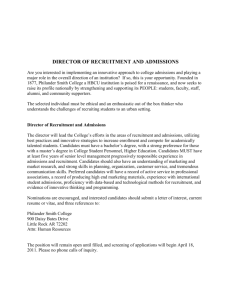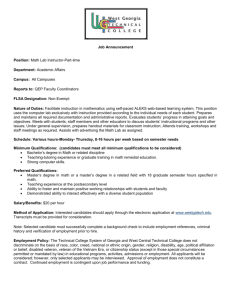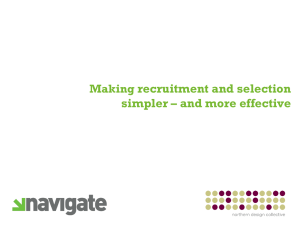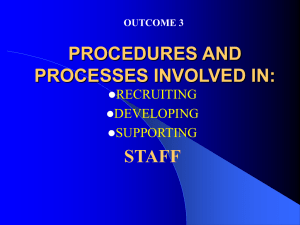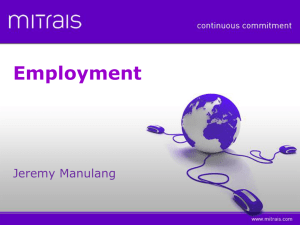Recruitment
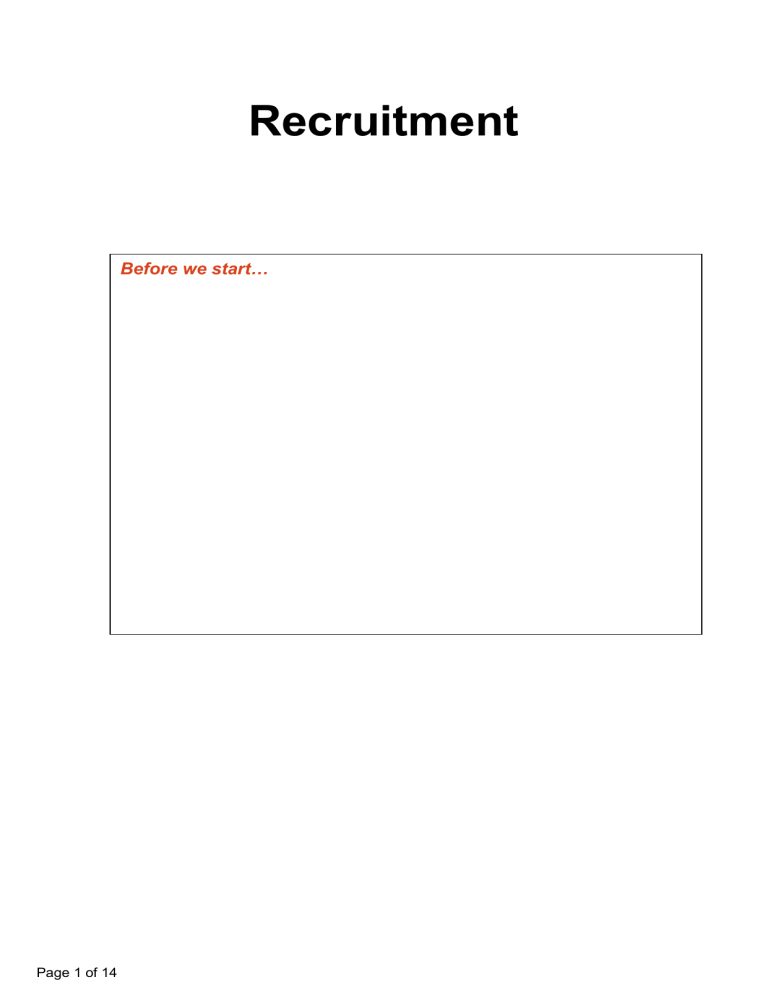
Recruitment
Before we start…
Page 1 of 14
Recruitment
This resource aims to support those who need to recruit and select research staff.
Recruitment is the process of identifying whether a vacancy does (or should) exist and interesting potential applicants in it.
Selection is the process of deciding which (if any) of the actual applicants is suitable.
It can be used as a standalone resource or as part of broader personal development.
Learning outcomes
By completing each section and its associated exercises, you will:
Gain a broad understanding of the importance of each part of the recruitment process and the possible danger spots.
Understand the legal framework relating to recruitment and selection.
Have a greater understanding on how a good or bad interview experience might impact on an applicant and the implications this could have for your research team.
Understand the importance of record keeping during the recruitment process.
Introduction - Getting it wrong
Think about recruitment and selection from beginning to end.
Write down as many items as you can of where things can go wrong and the implications.
Page 2 of 14
Getting it wrong – There is not enough money
Always check you have enough funding for your recruitment first
Getting it wrong – Poor job description
This will give candidates the wrong picture of what is required and you will get a pool of applicants not suitable for the job
Getting it wrong - Poor, unclear person specification
This makes it difficult for applicants to make their application concentrating on their qualifications, skills and attributes.
Short listing will be difficult and ultimately you will get a small pool of suitable candidates.
Most research funded jobs are specialist and typically you will get few applications anyway, so poorly written person specifications will make this worse.
Getting it wrong - Advertising in the wrong place
Getting this wrong may mean you do not attract your target applicants and you will not get many suitable applications
Getting it wrong - Short listing taking too long and then rushed
This is not fair on the success of your project and you may miss good applications as applicants will go elsewhere.
It is not fair on the applicants who have taken time and trouble to complete an application form.
Getting it wrong - References taken up at the last minute
This can hold up the selection process and gives the candidates the impression you are not really interested in them and they may want to go somewhere else.
It is not fair on the referees who may feel they have to rush the reference to meet a deadline
Page 3 of 14
Getting it wrong - Interview poorly structured
This does not get the best out of each candidate and gives them the feeling that your institution is not a good place to work.
Getting it wrong - Poorly worded questions and some against law
This gives the wrong impression and some questions that contravene legislation may mean a legal complaint e.g. Race/Sex Discrimination etc
Getting it wrong - Taking too long to make selection decision
This may mean good candidates go elsewhere.
Sometimes you do get two very strong candidates and you do wish to pursue the strongest one first e.g. chase references.
It is vital that you do not leave other appointable candidates without information as this gives a bad impression of you, your team and your institution.
If you are faced with this seek advice from HR.
Process of recruitment
Making a wrong decision, or adopting bad practice when recruiting research staff can be costly, not just in legal terms, but will effect the overall performance of your project.
Objectives
This section gives you the opportunity to appreciate the recruitment process as a whole. By the end of this section you should have a broad understanding of the importance of each recruitment process and the
Possible danger spots.
This section covers the following:
The recruitment process stages and exercise
Exercise on the pitfalls in the recruitment of research staff
Page 4 of 14
The recruitment process stages
The recruitment process begins when you have Approval to recruit into your research group. Methods of approval vary so you will need to follow the internal process.
Typically recruitment for research posts is dependant on funding within the award. You will need guidance from your institution on how to manage this part.
Remember that recruitment doesn't finish until after the appointment has been made and you have reflected on any changes that you would make in future recruitments.
Based on your knowledge, write down the different stages of the recruitment process in the sequence that they occur.
The recruitment process stages Quiz
Using the list below place each process in sequential order that the recruitment process should follow:
1) Advertise
2) Decide on selection methods and timescales
3) Identify vacancy
4) Interviews and test
5) Make final selection and give Feedback
6) Organise the panel and short –list
7) Prepare job description and person specification
8) References
Feedback below……….
Page 5 of 14
Feedback
1) Identify vacancy
Before you start you will need to identify your vacancy. If you are replacing someone who is leaving the project you might ask yourself:
Should the post be replaced at all?
Should it be replaced in a different way?
This provides an opportunity to reorganise the team and the responsibilities within it.
By changing the responsibilities of the post you may be able to fill a gap in the existing team making it more productive.
Have you got the funding? Without it you will not be able to start the recruitment process
2) Prepare job description and person specification
You will need to prepare a job description and person specification before you advertise.
3) Decide on selection methods and timescales
At this stage you might wish to consider other selection methods as well as the structured interview.
4) Advertise
You need to advertise the post in an appropriate publication or website.
5) Organise the panel and short –list
Confirming the membership of the selection panel is best done as early on a possible so that you ensure everyone is available and the recruitment assignment is not delayed.
You will need to ensure a prompt, fair short listing process involving the selection panel.
6) References
In line with your university’s processes, references with the job description and person specification need to be sent to referees in good time for the interview date itself.
Page 6 of 14
7) Interviews and test
You will need to conduct a well structured interview process in line with your institutions procedures.
For some posts, it may be appropriate for a work sample test.
8) Make final selection and give Feedback
Once the interviews have been completed you will need to ensure the panel makes a recommendation of who to appoint, or to make no appointment if no suitable candidates were interviewed.
Some unsuccessful candidates may request feedback on their performance. In such cases it is important you provide constructive feedback to enable them to consider how they may approach any future job application process.
Frequently Asked Questions regarding the employment of research staff
What are some of key questions you have regarding the employment of research staff?
The project is coming to an end and one member of staff is leaving.
Sometimes replacing a member of staff near the end of the project can be a problem:
The money is running low
You have not the time to recruit and train before the project ends
Do you need to replace the vacancy?
Can you manage without?
Can you reorganise some of the work and then recruit someone at a different level i.e. to complete more routine tasks and let the project team concentrate on the more complex aspects of the project? If you can do this and you need clerical or technical input, you may be able to save time in the recruitment process or even employ a temp or casual member of staff.
Please check what your local policies and procedures are beforehand.
Remember any solution will hinge on whether you have the money so check this first.
Page 7 of 14
A member of the team is on long term sick, the project is suffering
Anyone on long term sick will be covered by the institution’s terms and conditions of service and will have their employment rights associated with their contract. They will be entitled to sick pay in accordance with their contract.
Understandably you will have pressure to complete the project. You might want to check to see if there is any spare funding that you can use. Even if it means recruiting at a different level ( see note 1).
A member of staff is going on maternity leave
This can happen and the member of staff is covered by their contract of service and sex discrimination laws.
Check whether there are provisions in your grant for maternity pay and replacements for staff going on maternity leave.
Some bodies do not make provisions for this and you will need to check this out.
If the maternity leave occurs at the beginning of the project and you have permission to replace then you may wish to recruit in the normal way.
If the project is coming to an end you may wish to reorganise the work and recruit at a different level ( see note 2 ).
I want to employ a student
– they have the skills
I need
This is not fair recruitment practice, although the skills and expertise would be useful to you.
Students (assuming that they will have graduated or are working to the recommended number of hours for a student) will need to be recruited following a proper process and considered alongside other applicants.
The biggest pitfall here is the recruitment of students or ex students from non EC countries. Due to work permit rules, this is not always possible and can cause much hassle for you, the student and the organisation. There are very strict rules in the conversion of student visas to employment visas – mostly this is not possible.
It is not good practice to get anyone’s hopes up before you have checked if there are any issues surrounding a work permit.
Page 8 of 14
Job descriptions and person specifications
Before you start writing anything, review any existing job specification or write a new one. It is important to spend time to really think about what you need. Time spent here will make sure that you do not recruit in haste and affect the performance of your project.
Your institution’s recruitment procedures must be robust and justifiable and should stand up to external scrutiny. The Job Description and the Person
Specification form the basic foundations of a good process.
These documents outline the duties of the post and the skills required to do a job.
Candidates will be measured against the criteria written in these documents, so they should be well written, accurate, clear and unambiguous.
Once you have completed this section you should be more aware of the things to include in a Job Description and Person Specification.
You will understand the purpose of each document and how they differ from each other. You will have thought about the importance of making criteria appropriate, clear and measurable.
How to write a job description
Speak to all those involved with the post to establish tasks required and they agree with the role.
Describe accurately the requirements and duties of the job.
Avoid wording which implies that members of one sex are more likely to be able to do the job.
Do not use too much jargon otherwise you may not attract a wide enough pool of applicants.
It is good practice to split the job description into different tasks rather than produce one large paragraph of narrative.
It is important not to restrict the job description to only about four or five duties.
You may wish to include a paragraph about the project.
Page 9 of 14
Exercise on how to write a job description
Read the job description in the notes – Entitled “The University of Blank” and then answer the questions.
How to write a person specification
The Person Specification is a profile of the personal skills, qualifications, abilities and experiences you will look for in the recruitment and selection process.
The criteria you decide on should relate directly to the duties of the job description and contain the minimum requirements essential to do the job effectively.
These criteria should then form the basis of the advert in order to attract the most suitable candidates and the basis of the selection criteria.
For many research posts qualifications, abilities and experience are often specialised and it is likely that you attract only a small number of applicants.
It is a good idea to stand back and really question whether what you have drafted as essential criteria are really essential.
Sometimes you may be able to train staff in certain specialist skills and thus you may widen the pool of applicants.
It is not good practice to base the specifications on the personal qualities of the person currently in post rather than the tasks needed.
Suggestions for drawing up a Person
Specification
1) From the job description pick out the duties, grouping together those which are similar.
2) Translate duties into the abilities and skills needed to do the job.
Specify necessary skills as far as possible in precise job-related terms.
3) Identify any specific knowledge requirements for the job or requirement of some evidence of ability to learn.
4) Where relevant indicate qualifications and level of education required for the job, be as precise as possible.
5) Identify experience required to carry out the job. Define the extent.
6) Decide which skills, experiences, qualifications are essential to the job and which are only desirable.
7)
Page 10 of 14
Essential and desirable specifications
Essential means that this is the minimum criterion needed to carry out the job and the job cannot be done without these criteria.
No one without these criteria will be offered the job, no matter what other attributes they might possess.
Desirable refers to those criteria which are not essential; someone could do the job without this.
If more than one candidate satisfies the essential criteria, specified desirable attributes can be taken into account in selection (it may be useful to set out the desirable criteria in order of priority).
Attributes not identified as either essential or desirable should not be taken into consideration in the selection process.
Be aware that different institutions will ask you for different formats in the presentation of a person specification.
Some will ask you to identify which criteria you will short list against at application form stage.
This is because there are certain attributes required for jobs that cannot be tested on paper such as “interpersonal skills”, “oral communication”, and
“presentation skills”.
This is much fairer and you should be able to defend easily any complaint made by an unsuccessful applicant after initial short listing.
Some institutions may ask you to indicate from where you will gather the evidence to match any applicant to the person specification e.g. application form, interview, presentation etc.
Advertise
Posts should be advertised in appropriate areas e.g. jobs.ac.uk correct publications and journals. You will need to be aware of any rules and procedures in your institution.
Draft the advertisement to reflect job description and person specification.
It is good practice to give closing date of a minimum of two weeks after the advertisement appears.
You will need to check what rules there are with regard to closing dates in your own institution.
Page 11 of 14
Do all research posts have to be advertised?
Not all vacancies are advertised.
Write down some scenarios where there may not be a need to advertise
Short listing
Objectives
Once you have completed this section you will understand the importance of short-listing and use of rigorous systems to maintain the fairness of the selection procedures.
The role of selection criteria
The production of selection criteria, mutually agreed by the panel, forms the core of a fair and effective selection process.
It is important for fair selection because:
While no selection of people can be made completely objective, it should be the aim of the selection panel to reduce as far as possible the subjective nature of the process, which can inadvertently lead to unfair discrimination.
All panel members should be able to assess candidates against the same standards.
If candidates know what standard they are being assessed against, selection is seen to be fair.
It is important for effective selection because:
The availability of written selection criteria enables a panel to carry out the selection in an organised and efficient way; it makes short-listing easier and interviewing more focused.
To some extent unsuitable candidates are enabled to 'deselect' themselves, particularly if key selection criteria are reproduced in the advertisement for the post.
A detailed job description should be used as the basis for drawing up selection criteria, so that all criteria relate to the post in question and not, for example, to the qualities of the previous post-holder. For jobs which normally attract large numbers of applicants, there may be a temptation to include more criteria or set higher standards than are necessary.
This should be resisted: not only may it result in indirect discrimination, but an over-qualified candidate may be appointed, with job dissatisfaction the potential consequence.
Page 12 of 14
Setting criteria for short-listing
Selection criteria should include the skills, abilities and qualifications required of the successful candidate. Other requirements, such as availability to work unsociable or long hours, should also be listed.
Selection criteria that you use must be clearly stated in the person specification. A distinction should be made between the selection criterion itself and the evidence which may show that a candidate meets the criterion.
Ideally all criteria should be capable of being measured, either through candidates' applications or CVs, the interview or a selection test. This becomes difficult when qualities such as motivation, enthusiasm or a pleasant personality are included.
It is useful to consider carefully how such criteria relate to the job description, what means would be used to assess candidates against them and what kind of evidence would be acceptable.
This is an area where personal preferences can unconsciously influence decisions, and an undefined feeling that someone 'wouldn't fit in' can lead to a candidate being unfairly rejected.
The Equal Opportunities Commission recommends that candidates should receive as much information as possible about the post for which they are applying.
Accordingly, consideration should be given to including the full selection criteria in the information sent to candidates.
This is good practice in terms of equal opportunities; it also enables the candidates to make an informed decision about whether or not to apply for the post, thus reducing the likelihood of large numbers of applications from clearly unsuitable candidates.
You will already have thought about the person specification and how and where qualifications, skills and attributes can be assessed in the recruitment procedure in the section about how to write a person specification.
Page 13 of 14
Short listing candidates for research posts
Arrange for the selection panel to meet to short list (click here for some notes about the selection panels for research staff)
Send out papers in advance
Agree which criteria you will short list against and ensure that these can be assessed from an application form
Use the selection criteria on the job description and person specification
Each candidate should be assessed against all the selection criteria, and not against each other
With a large number of applications, it may be more appropriate to select first by reference to the 'essential' criteria, applying the
'desirable' criteria in the course of a second round if it is necessary to reduce the numbers still further
Do not introduce any extra criteria as this is unfair and could be discriminatory
Keep a record of the short-listing process, including an indication of the reasons for selection or rejection in each case. Such records may be required by an employment tribunal in the case of a complaint of unlawful discrimination. You may wish to use a chart
(click here)
Write to unsuccessful candidates – unless this is done centrally for you
Conclusion - Recruitment
The aim of this resource was to support those who need to recruit and select research staff.
Recruitment is the process of identifying whether a vacancy does (or should) exist and interesting potential applicants in it.
Selection is the process of deciding which (if any) of the actual applicants is suitable.
Page 14 of 14



